Waterspout
A waterspout is an intense columnar vortex (usually appearing as a funnel-shaped cloud) that occurs over a body of water.[1] Some are connected to a cumulus congestus cloud, some to a cumuliform cloud and some to a cumulonimbus cloud.[2] In the common form, it is a non-supercell tornado over water.[2][3][4]
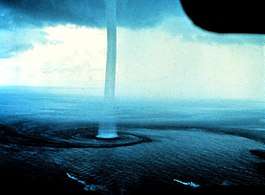
| Part of a series on |
| Weather |
|---|
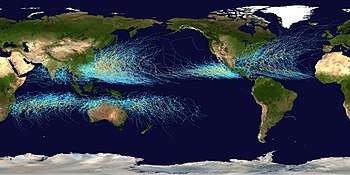 |
|
|
While it is often weaker than most of its land counterparts, stronger versions spawned by mesocyclones do occur.[5][6] Most waterspouts do not suck up water; they are small and weak rotating columns of air over water.[2][7]
While waterspouts form mostly in the tropics and subtropical areas,[2] other areas also report waterspouts, including Europe, Australia, New Zealand, the Great Lakes, Antarctica[8][9] and on rare occasions, the Great Salt Lake.[10] Some are also found on the East Coast of the United States, and the coast of California.[1] Although rare, waterspouts have been observed in connection with lake-effect snow precipitation bands.
Waterspouts have a five-part life cycle: formation of a dark spot on the water surface, spiral pattern on the water surface, formation of a spray ring, development of the visible condensation funnel, and ultimately decay.
Formation
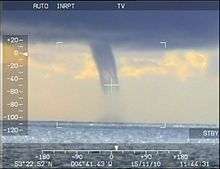
Waterspouts exist on a microscale, where their environment is less than two kilometers in width. The cloud from which they develop can be as innocuous as a moderate cumulus, or as great as a supercell. While some waterspouts are strong and tornadic in nature, most are much weaker and caused by different atmospheric dynamics. They normally develop in moisture-laden environments as their parent clouds are in the process of development, and it is theorized they spin as they move up the surface boundary from the horizontal shear near the surface, and then stretch upwards to the cloud once the low level shear vortex aligns with a developing cumulus cloud or thunderstorm. Some weak tornadoes, known as landspouts, have been shown to develop in a similar manner.[11]
More than one waterspout can occur in the same vicinity at the same time. As many as nine simultaneous waterspouts have been reported on Lake Michigan.[8]
Types
Non-tornadic
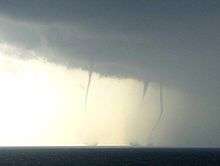
Waterspouts that are not associated with a rotating updraft of a supercell thunderstorm are known as "non-tornadic" or "fair-weather waterspouts", and are by far the most common type. Fair-weather waterspouts occur in coastal waters and are associated with dark, flat-bottomed, developing convective cumulus towers. Waterspouts of this type rapidly develop and dissipate, having life cycles shorter than 20 minutes.[11] They usually rate no higher than EF0 on the Enhanced Fujita scale, generally exhibiting winds of less than 30 m/s (67 mph; 108 km/h).[12]
They are most frequently seen in tropical and sub-tropical climates, with upwards of 400 per year observed in the Florida Keys.[13] They typically move slowly, if at all, since the cloud to which they are attached is horizontally static, being formed by vertical convective action instead of the subduction/adduction interaction between colliding fronts.[13][14] Fair-weather waterspouts are very similar in both appearance and mechanics to landspouts, and largely behave as such if they move ashore.[13]
Tornadic
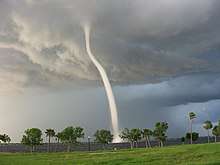
"Tornadic waterspouts", also accurately referred to as "tornadoes over water", are formed from mesocyclones in a manner essentially identical to land-based tornadoes in connection with severe thunderstorms, but simply occurring over water.[15] A tornado which travels from land to a body of water would also be considered a tornadic waterspout.[16] Since the vast majority of mesocyclonic thunderstorms occur in land-locked areas of the United States, true tornadic waterspouts are correspondingly rarer than their fair-weather counterparts in that country. However, in some areas, such as the Adriatic, Aegean and Ionian seas,[17] tornadic waterspouts can make up half of the total number.[18]
Snowspout
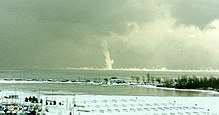
A winter waterspout, also known as a snow devil, an icespout, an ice devil, a snownado, or a snowspout, is an extremely rare instance of a waterspout forming under the base of a snow squall.[19][20] The term "winter waterspout" is used to differentiate between the common warm season waterspout and this rare winter season event. Very little is known about this phenomenon and only six known pictures of this event exist to date, four of which were taken in Ontario, Canada. There are a couple of critical criteria for the formation of a winter waterspout. Very cold temperatures need to be present over a body of water warm enough to produce fog resembling steam above the water's surface. Like the more efficient lake-effect snow events, winds focusing down the axis of long lakes enhance wind convergence and likely enhance their development.[21]
Climatology
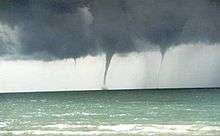
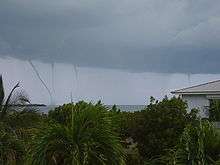
Though the majority of waterspouts occur in the tropics, they can seasonally appear in temperate areas throughout the world, and are common across the western coast of Europe as well as the British Isles and several areas of the Mediterranean and Baltic Sea. They are not restricted to saltwater; many have been reported on lakes and rivers including the Great Lakes and the St. Lawrence River.[22] Waterspouts are fairly common on the Great Lakes during late summer and early fall, with a record 66+ waterspouts reported over just a seven-day period in 2003.[23] They are more frequent within 100 kilometers (60 mi) from the coast than farther out at sea. Waterspouts are common along the southeast U.S. coast, especially off southern Florida and the Keys and can happen over seas, bays, and lakes worldwide. Approximately 160 waterspouts are currently reported per year across Europe, with the Netherlands reporting the most at 60, followed by Spain and Italy at 25, and the United Kingdom at 15. They are most common in late summer. In the Northern Hemisphere, September has been pinpointed as the prime month of formation. [24] Waterspouts are frequently observed off the east coast of Australia,[25][26] with several being described by Joseph Banks during the voyage of the Endeavour in 1770.[27]
Life cycle
There are five stages to the waterspout life cycle. Initially, a prominent circular, light-colored disk appears on the surface of the water, surrounded by a larger dark area of indeterminate shape. After the formation of these colored disks on the water, a pattern of light and dark-colored spiral bands develop from the dark spot on the water surface. Then, a dense annulus of sea spray, called a cascade, appears around the dark spot with what appears to be an eye. Eventually, the waterspout becomes a visible funnel from the water surface to the overhead cloud. The spray vortex can rise to a height of several hundred feet or more and often creates a visible wake and an associated wave train as it moves. Eventually, the funnel and spray vortex begin to dissipate as the inflow of warm air into the vortex weakens, ending the waterspout's life cycle.[14]
Marine hazard
Waterspouts have long been recognized as serious marine hazards. Stronger waterspouts pose threats to watercraft, aircraft and people.[28] It is recommended to keep a considerable distance from these phenomena, and to always be on alert through weather reports. The United States National Weather Service will often issue special marine warnings when waterspouts are likely or have been sighted over coastal waters, or tornado warnings when waterspouts are expected to move onshore.[29]
Incidents of waterspouts causing severe damage and casualties are rare. However, there have been several notable examples. The Malta tornado in 1555 was the earliest record of a deadly waterspout. It struck the Grand Harbour of Valletta, sinking four galleys, numerous boats, and claiming hundreds of lives.[30] The 1851 Sicily Tornadoes were twin waterspouts that made landfall in western Sicily, ravaging the coast and countryside before ultimately dissipating back again over the sea.
Threat to marine animals
Depending on how fast the winds from a waterspout are whipping, anything that is within about 90 cm (1 yard) of the surface of the water, including fish of different sizes, frogs, and even turtles, can be lifted into the air.[31] A waterspout can sometimes suck small animals such as fish out of the water and all the way up into the cloud. Even if the waterspout stops spinning, the fish in the cloud can be carried over land, buffeted up and down and around with the cloud's winds until its currents no longer keep the flying fish in the atmosphere. Depending on how far they travel and how high they are taken into the atmosphere, the fish are sometimes dead by the time they rain down. People as far as 160 km (100 miles) inland have experienced raining fish.[31] Fish can also be sucked up from rivers, but raining fish is not a common weather phenomenon.[31]
Research and forecasting
Szilagyi Waterspout Index
The Szilagyi Waterspout Index (SWI), developed by Canadian meteorologist Wade Szilagyi, is used to predict conditions favorable for waterspout development. The SWI ranges from −10 to +10, where values greater than or equal to zero represent conditions favorable for waterspout development.[32][33]
International Centre for Waterspout Research
The International Centre for Waterspout Research (ICWR) is a non governmental organization of individuals from around the world who are interested in the field of waterspouts from a research, operational and safety perspective.[34] Originally a forum for researchers and meteorologists, the ICWR has expanded interest and contribution from storm chasers, the media, the marine and aviation communities and from private individuals.
Myths
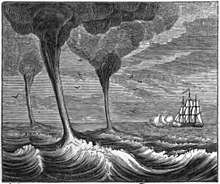
There was a commonly held belief among sailors in the 18th and 19th centuries that shooting a broadside cannon volley dispersed waterspouts.[35][36][37] Among others, Captain Vladimir Bronevskiy claims that it was a successful technique, being an eye-witness to the dissipation of a phenomenon in the Adriatic while being a midshipman aboard the frigate Venus during the 1806 campaign under Admiral Senyavin.[38]
A waterspout has been proposed as a possible reason for the inexplicable abandonment of the Mary Celeste.[39]
See also
| Wikimedia Commons has media related to Waterspouts. |
References
- Burt, Christopher (2004). Extreme weather : a guide & record book. Cartography by Stroud, Mark. (1st ed.). New York: W.W. Norton. ISBN 978-0393326581. OCLC 55671731.
- "Waterspout definition". A Comprehensive Glossary Of Weather. Geographic.org. Retrieved 10 July 2014.
- What Is a Waterspout? (Weather Channel video)
- Waterspout comes ashore in Galveston by Jessica Hamilton, Houston Chronicle, July 17, 2016
- Answer.com (ed.). "Waterspout". McGraw-Hill Encyclopedia of Science and Technology. Retrieved 6 December 2010.
- Keith C. Heidorn. Islandnet.com (ed.). "Water Twisters". The Weather Doctor Almanach. Retrieved 6 December 2010.
- Schwiesow, R.L.; Cupp, R.E.; Sinclair, P.C.; Abbey, R.F. (April 1981). <0341:WVMBAD>2.0.CO;2 "Waterspout Velocity Measurements by Airborne Doppler Lidar". Journal of Applied Meteorology. 20 (4): 341–348. Bibcode:1981JApMe..20..341S. doi:10.1175/1520-0450(1981)020<0341:WVMBAD>2.0.CO;2.
- "Several waterspouts filmed on Lake Michigan in US". BBC News. 20 August 2012. Retrieved 20 August 2012.
- Taylor, Stanley (August 2011). "Antarctic Diary". Retrieved 4 June 2013.
- Joanne Simpson; G. Roff; B. R. Morton; K. Labas; G. Dietachmayer; M. McCumber; R. Penc (December 1991). "A Great Salt Lake Waterspout". Monthly Weather Review. AMS. 119 (12). doi:10.1175/1520-0493-119-12-2740.1.
- Choy, Barry K.; Scott M. Spratt. "Using the WSR-88D to Predict East Central Florida Waterspouts". National Oceanic and Atmospheric Administration. Archived from the original on 5 October 2006. Retrieved 25 October 2006.
- National Weather Service Forecast Office, Milwaukee/Sullivan, WI (30 April 2008). "Threat Definitions for Waterspouts". National Weather Service Central Region Headuqaters. Retrieved 27 August 2009.
- National Weather Service in Key West, Florida (12 September 2002). "Waterspouts". Basic Spotter Training Version 1.2. NOAA. pp. 4–24. Archived from the original on 9 October 2007. Retrieved 21 July 2008.
- Bruce B. Smith (22 February 2007). "Waterspouts". National Weather Service Central Region Headquarters. Retrieved 21 June 2009.
- National Weather Service Forecast Office, Melbourne, Florida (25 January 2007). "Graphical Hazardous Weather Outlook: Waterspout Threat". Southern Region Headquarters. Archived from the original on 19 December 2005. Retrieved 21 June 2009.
- Waylon G. Collins; Charles H. Paxton; Joseph H. Golden (February 2000). <0122:TJPCFT>2.0.CO;2 "The 12 July 1995 Pinellas County, Florida, Tornado/Waterspout". Weather and Forecasting. 15 (1): 122–134. Bibcode:2000WtFor..15..122C. doi:10.1175/1520-0434(2000)015<0122:TJPCFT>2.0.CO;2.
- Rare: Waterspout tornado came ashore in Palermo, Sicily, Italy - August 6, 2020
- Michalis V. Sioutasa & Alexander G. Keul (February 2007). "Waterspouts of the Adriatic, Ionian and Aegean Sea and their meteorological environment". Journal of Atmospheric Research. 83 (2–4): 542–557. Bibcode:2007AtmRe..83..542S. doi:10.1016/j.atmosres.2005.08.009.
- The Buffalo News (14 April 2003). "Waterspouts". State University of New York in Buffalo. Retrieved 21 July 2008.
- The Weather Channel (2008). "Snow Devil". Glossary. Archived from the original on 1 August 2008. Retrieved 21 July 2008.
- National Weather Service Forecast Office, Burlington, Vermont (3 February 2009). "15 January 2009: Lake Champlain Sea Smoke, Steam Devils, and Waterspout: Chapters IV and V". Eastern Region Headquarters. Retrieved 21 June 2009.
- Canadian Television News Staff (23 July 2008). "Rare waterspout forms in Montreal during storm". Retrieved 21 June 2009.
- National Oceanic and Atmospheric Administration (4 December 2009). "The Great Waterspout Outbreak of 2003". Retrieved 6 August 2009.
- Wade Szilagyi from the Meteorological Service of Canada (December 2004). "The Great Waterspout Outbreak of 2003". Mariners Weather Log. NOAA. 43 (3). Retrieved 25 October 2006.
- Gibson, Jano (14 June 2007). "Waterspout off Sydney". The Sydney Morning Herald. Retrieved 23 January 2010.
- "Water spout touches down off Sydney beaches". Daily Telegraph. 8 July 2008. Retrieved 23 January 2010.
- Banks, Joseph (1997). The Endeavour Journal of Sir Joseph Banks, 1768–1771. University of Sydney Library.
- Auslan Cramb (7 August 2003). "Water Spout Hit Helicopter". The Telegraph. Retrieved 21 June 2009.
- National Weather Service Forecast office, Melbourne, Florida (25 January 2007). "Graphical Hazardous Weather Outlook: Waterspout Threat". Southern Region Headquarters. Archived from the original on 1 October 2006. Retrieved 21 June 2009.
- Abela, Joe. "Claude de la Sengle (1494 - 1557)". Senglea Local Council. Retrieved 11 November 2015.
- Susan Cosier (17 September 2006). "It's Raining Fish: Unusual objects sometimes fall from the sky, courtesy of waterspouts". Scienceline (Physical Science). NYU Journalism. Retrieved 17 May 2015.
- Szilagyi, Wade (12–16 October 2009). "A Waterspout Forecasting Technique" (PDF). Pre-prints. 5h European Conference on Severe Storms. Landshut – GERMANY. pp. 129–130.
- Sioutas Michalis, Szilagyi Wade & Κeul Alexander (2013). "Waterspout Outbreaks over areas of Europe and North America: Environments and Predictability". Atmospheric Research. 123: 167–179. Bibcode:2013AtmRe.123..167S. doi:10.1016/j.atmosres.2012.09.013.
- "The International Centre For Waterspout Research". Retrieved 10 December 2011.
- The Universal Magazine of Knowledge and Pleasure. 6 and 7. 1750. p. 154.
- American Journal of Science and Arts. S. Converse. 1849. p. 266.
- Robert Johnson (1810). The Adventures of Captain Robert Johnson. Thomas Tegg. p. B2.
- Naval Memoirs of Vladimir Brovevskiy (in Russian). Тип. Императорской Росс. Акад. 1837. p. 322.
- Begg, Paul (2007). Mary Celeste: The Greatest Mystery of the Sea. Harlow: Pearson Education. pp. 140–146. ISBN 978-1-4058-3621-0.
External links
General
- A series of pictures from the boat Nicorette approaching the NSW south coast tornadic waterspout.
- A USA Today online article on waterspouts: https://www.usatoday.com/weather/wspouts.htm
- Online waterspout article
- Pictures of cold-core waterspouts over Lake Michigan on 30 September 2006. Archived from the original on 10 March 2007.
- Large waterspout off southern Tongatapu, February 2014
- http://aoss-research.engin.umich.edu/PlanetaryEnvironmentResearchLaboratory/
- Experimental Great Lakes Forecast
Winter waterspout
- A Winter Waterspout Monthly Weather Review, February 1907.
